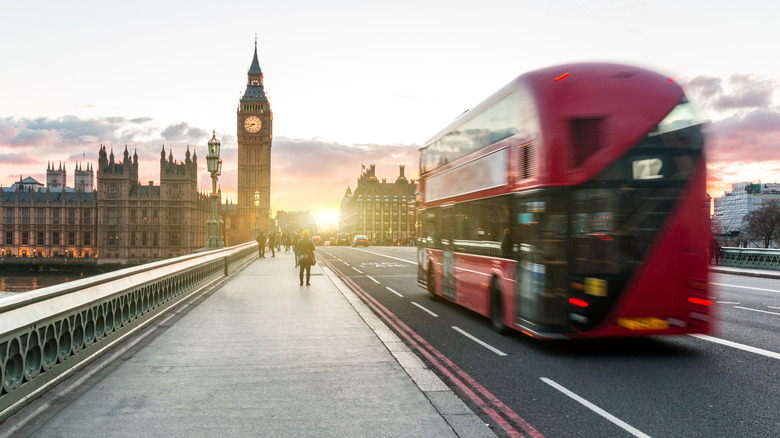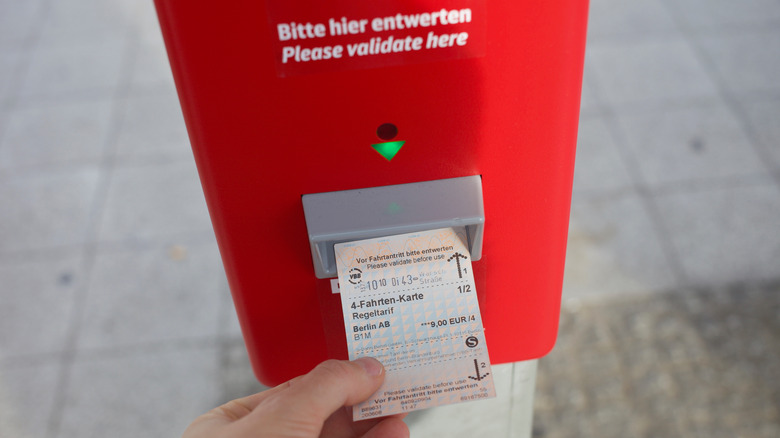Rick Steves' Tips For Navigating Europe's City Bus System
When you're backpacking through Europe, one of the most recognizable and tourist-friendly modes of transportation are the hop-on, hop-off buses that allow you to visit all the major sights on one reusable ticket for 24 hours. The caveat, however, is that these buses are pretty expensive. For example, the Paris Big Bus Tour costs €40.50, or over $42 USD! If you're on a strict budget, that bus tour could cost more than your daily allowance for food! Luckily, hopping on a local city bus is easier on the purse strings. Think of the iconic red double-decker city buses in London, or the gorgeous trams and streetcars that ding-ding their way through Amsterdam. A visit to either city isn't complete without at least one ride on these legendary conveyances.
As easy as this sounds, when you're in a city where you don't speak the language and you don't know how things work, getting on a city bus, tram, or subway alongside the locals can feel intimidating. Luckily, one of the most trusted names in travel, Rick Steves, has got you covered. He regularly shares tips and tricks to make your journey on the European public transportation systems that much easier. Here's all the advice Rick Steves has to get the most out of Europe's public transportation.
Smartphone apps are your best resource
These days, when trying to find your way around a foreign city, your smartphone is going to be your best tool. And we're not just talking about Google Maps (although that is usually a great resource). Travel expert Rick Steves recommends on his official website to use a mapping app like Citymapper to figure out the bus and transportation system when you're trying to get around Europe. Citymapper is a public transportation app that allows you to view and download bus schedules, route maps, and timetables. Another option that works in Europe is the Umo Mobility app (previously known as NextBus).
Most city metropolitan transportation services offer their own app as well. If you're spending an extended period of time in Switzerland, the SBB app is for you. If you're in London, make sure you get the TFL Go app. The Paris app RATP allows you buy tickets on your phone. Same goes for the BVG app, which works for all modes of public transportation in Berlin.
The great thing about using public transportation as opposed to the hop-on, hop-off buses is that you can still reach all the major tourist destinations at a fraction of the cost. If you're okay eschewing the audio guide that comes with the tourist bus and relying on your guidebook, you can still reach the Tower of London or the Eiffel Tower for the equivalent of a few dollars.
Validating your ticket is required in many cities
One confusing detail of European buses, trams, and other modes of public transportation is the validation system, which isn't something we normally have in North America. When you buy a paper ticket, on many buses you will see a machine box attached to a pole where you're required to validate your ticket. Once inserted, the machine time and date stamps your paper ticket. You will encounter this validation method in cities like Prague, Zurich, Budapest, and many others. So Rick Steves recommends that you pay attention to what the locals are doing with their paper tickets, and follow suit. In many cities, if you fail to validate your ticket and are caught by a fare inspection officer, you could face a fine.
Steves also reminds foreign tourists using the trams and streetcars in cities like Prague, Vienna, Amsterdam, and Copenhagen to look right before you exit. In these cities, quite often the tram stops let passengers off either right into traffic or in a bike lane. Make sure oncoming traffic is fully stopped before exiting the streetcar! If you're in London and using the trams, remember that traffic goes in the opposite direction, so look left.


